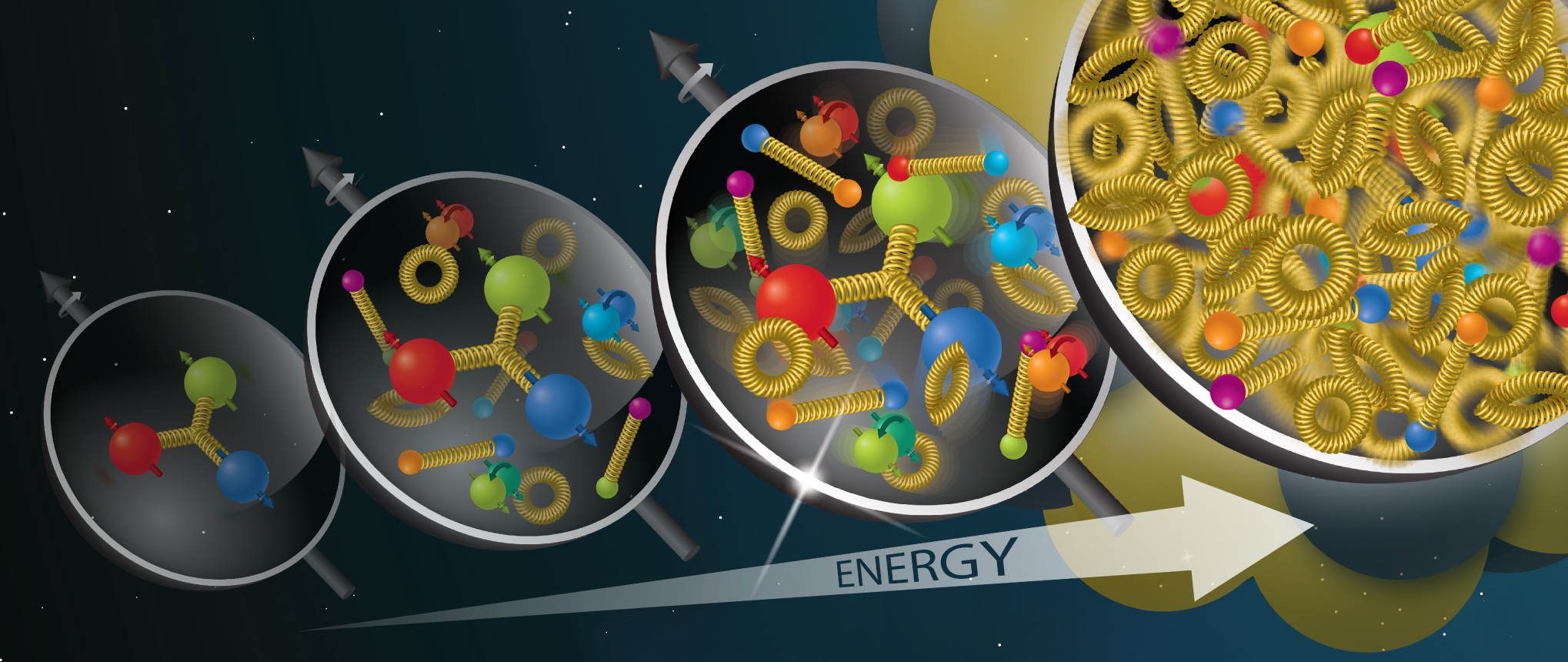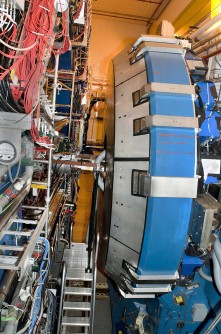A proton’s core consists of three valence quarks, but they contribute only a small fraction of the proton’s mass. Most of the mass emerges from intricate quark dynamics and is primarily governed by the strong force mediated by gluons.
Tag: Gluons
Signs of Gluon Saturation Emerge from Particle Collisions
By colliding protons with heavier ions and tracking particles from these collisions, scientists can study the quarks and gluons that make up protons and neutrons. Recent results revealed a suppression of certain back-to-back pairs of particles that emerge from interactions of single quarks from the proton with single gluons in the heavier ion. The results suggest that gluons in heavy nuclei recombine, a step toward proving that gluons reach a postulated steady state called saturation, where gluon splitting and recombination balance.
New Type of Entanglement Lets Scientists ‘See’ Inside Nuclei
Nuclear physicists have found a new way to see inside nuclei by tracking interactions between particles of light and gluons. The method relies on harnessing a new type of quantum interference between two dissimilar particles. Tracking how these entangled particles emerge from the interactions lets scientists map out the arrangement of gluons. This approach is unusual for making use of entanglement between dissimilar particles—something rare in quantum studies.

Brookhaven Lab to Lead New ‘Saturated Glue’ Theory Collaboration
The U.S. Department of Energy (DOE) has announced funding for a new Topical Theory Collaboration to be led by DOE’s Brookhaven National Laboratory that will aid in the discovery and exploration of a saturated state of gluons. These aptly named particles carry the nuclear strong force, acting as the ‘glue’ that holds together quarks, the building blocks of all visible matter.
Department of Energy Announces $11.24 Million for Research on Nuclear Theory Topical Collaborations
Today, the U.S. Department of Energy (DOE) announced $11.24 million for five topical theory collaborations in nuclear physics (NP). These projects bring together leading nuclear theorists to collaboratively focus on solving challenging problems central to advancing knowledge in nuclear physics.
Signs of Saturation Emerge from Particle Collisions at RHIC
Nuclear physicists studying particle collisions at the Relativistic Heavy Ion Collider (RHIC) have new evidence that particles called gluons reach a steady “saturated” state inside the speeding ions.
‘Shining’ Light on the Inner Details and Breakup of Deuterons
Scientists have found a way to “see” inside deuterons, the simplest atomic nuclei, to better understand how particles called gluons are arranged within the deuteron. These collisions can also break the deuteron apart, giving insights into what holds the proton and neutron together. The research helps scientists understand how nuclei emerge from quarks and gluons, and how the masses of nuclei are dynamically generated by gluons.

A look into the mysteries of proton structure and the dynamics of antiquarks and gluons
A complex high-energy nuclear physics experiment, aiming to measure the contributions of antiquarks to the structure of the proton and neutron, has produced results that are the opposite of what had previously been understood about proton structure and the dynamics of strong interacting antiquarks and gluons.

Analyzing Matter’s Building Blocks
Nobuo Sato is working to put the know in femto. He’s just been awarded a five-year, multimillion dollar research grant by the Department of Energy to develop a “FemtoAnalyzer” that will help nuclear physicists image the three-dimensional internal structure of protons and neutrons. Now, Sato is among 76 scientists nationwide who have been awarded a grant through the DOE Office of Science’s Early Career Research Program to pursue their research.

Theorist Takes Aim at the Makeup of Matter
Quarks and gluons are elementary particles that make up everything you see before you, including yourself, and Nobuo Sato wants to know how. At the Department of Energy’s Thomas Jefferson National Accelerator Facility, he will be tackling this question as the recipient of the JSA/Jefferson Lab Nathan Isgur Fellowship for Nuclear Theory.

STAR Gains Access to “Wimpy” Quarks and Gluons
Low-momentum (wimpy) quarks and gluons contribute to proton spin, offering insights into protons’ behavior in all visible matter. The Science The “proton spin puzzle” concerns how much the building blocks of the proton, quarks and gluons, and their motion within…